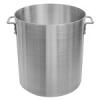Looking it up it's metal micro flakes within an epoxy / polyurethane resin base.
So it's metal dust in glue. 
Joking... Not joking...
The question should be "is painted stuff ever acceptable in a food factory". Sadly you can't get some bits of equipment in 316 or 304 Stainless Steel. So it's a reluctant and qualified yes but ideally only low risk. Well out of product zone. Ideally hidden in a cabinet that's well sealed.
But does this have any benefits over other paint?
It may or may not have been raised to a technical person in a low risk food manufacturing facility that they were constantly getting non conformances for damaged old metal mixer frames (away from product zone). This Technical person may or may not have suggested that they switch the colour of hammerite from white to silver because it wouldn't show the damage.
Look, I *ahem* I mean, this Technical person  is now older, wiser and wouldn't pull those kind of stunts anymore. But buying something with metal flakes in is just painting with it because it looks like solid metal? Not ideal. No better than paint in my opinion. Although I guess if it flakes it's metal detectable?
is now older, wiser and wouldn't pull those kind of stunts anymore. But buying something with metal flakes in is just painting with it because it looks like solid metal? Not ideal. No better than paint in my opinion. Although I guess if it flakes it's metal detectable?
(By the way, it may have meant that we, I mean, the site, didn't get that non conformance that year. )
Edited by GMO, 10 May 2024 - 03:18 PM.














